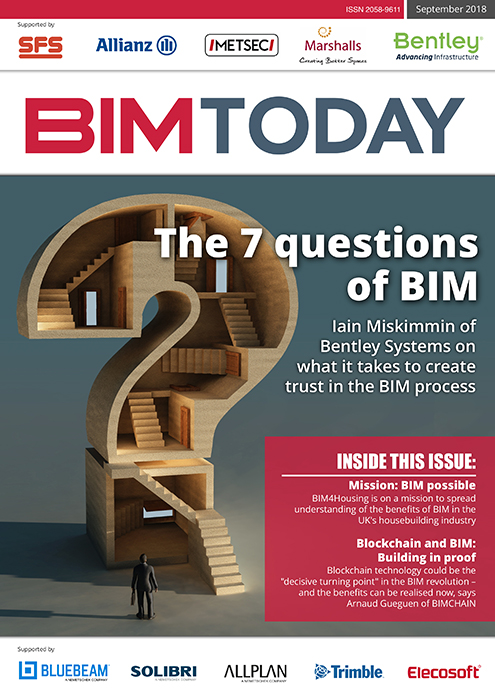Welcome to the September edition of BIM Today.
In this issue, Iain Miskimmin of Bentley Systems explores the Seven Questions of BIM – the key considerations from pre-bid prep through to “human terrain”, resources, delivery and quality that define a successful BIM-enabled project and digital asset.
Elsewhere, Arnaud Gueguen of BIMCHAIN discusses the emergence of blockchain technology in the BIM arena – and why he believes it will be the “decisive turning point” in the building information modelling revolution.
We also have Andrew Carpenter talking about the work of BIM4Housing; Terry Stocks of the Centre for Digital Built Britain on sizing up the benefits of BIM Level 2; and Eugenio Quintieri discussing the creation of the European Construction Industry Manifesto for Digitalisation.
Here’s a selection of what’s on offer:
Iain Miskimmin of Bentley Systems examines the seven key questions that need to be addressed to ensure trust in the BIM process and the successful delivery of a digital asset.
Blockchain technology could be the future of BIM – and the benefits can be realised today. Arnaud Gueguen of BIMCHAIN explains how.
The construction industry is jointly working towards an inclusive and multi-beneficial digitalisation of the sector. Here, Eugenio Quintieri of the European Builders Confederation discusses the collaborative effort to develop a manifesto for transformation.
Andrew Carpenter, chief executive of the Structural Timber Association and chair of BIM4Housing, discusses the cross-industry group’s mission of spreading the benefits of BIM in the housebuilding industry.
BIM is championed as the key to leveraging whole-life value to construction projects – but how can those benefits be measured? Terry Stocks, head of the UK BIM L2 Programme at the Centre for Digital Built Britain, takes an overview of the recently published BIM Benefits Methodology and Report.
Developing low carbon, affordable buildings is a key challenge for the construction industry. What if technology could be harnessed to create power-generating, “energy-positive” structures? Dr Justin Searle, technology director of the SPECIFIC Innovation & Knowledge Centre at Swansea University, discusses a project that is doing just that.
When it comes to complex construction and infrastructure projects, the margins between success and potential disaster can be measured in millimetres. Dave Holland, engineering director at Mabey, takes a look at the importance of real-time monitoring.
The digital twin – a virtual model of a real-life asset – is opening up new opportunities in design, construction and management while avoiding the costly delays associated with making changes on site. Mike Shilton of Keysoft Solutions and chair of the Landscape Institute Digital Practice Group explains how the concept is being applied in landscape design.
Simon Lewis and Vicky McCombe from law firm Womble Bond Dickinson look at the Asset Information Model that was introduced into the second edition of the CIC BIM protocol and the implications of using the protocol for the facilities management phase of a project.
Construction industry speakers meeting at the fifth British Information Modelling Event made a unanimous plea for change in the sector.


